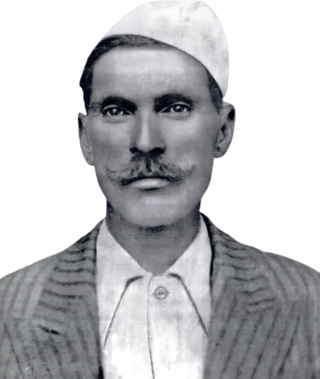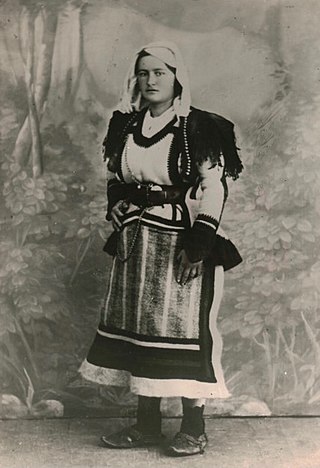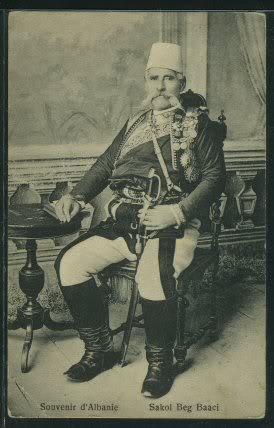
Malësia e Madhe, known simply as Malësia, is a historical and ethnographic region in northern Albania and eastern central Montenegro corresponding to the highlands of the geographical subdivision of the Malësi e Madhe District in Albania and Tuzi Municipality in Montenegro. The largest settlement in the area is the town of Tuzi.

Tuzi is a small town in Montenegro and the seat of Tuzi Municipality, Montenegro. It is located along a main road between the city of Podgorica and the Albanian border crossing, just a few kilometers north of Lake Skadar. The Church of St. Anthony and Qazimbeg's Mosque are located in the centre of the town. Tuzi is the newest municipality in Montenegro, having been an independent municipality since 1 September 2018.

Dedë Gjon Luli Dedvukaj also referred to as Ded Gjo Luli and Deda was an Albanian guerrilla leader most notable for commanding the 1911 revolt against Ottoman troops. He was posthumously awarded the "Hero of Albania" title. Dedvukaj was the clan chieftain of the Hoti tribe.
Albanians in Montenegro are an ethnic group in Montenegro of Albanian descent, which constitute 4.91% of Montenegro's total population. They are the largest non-Slavic ethnic group in Montenegro.

Kelmendi is a historical Albanian tribe (fis) and region in Malësia and eastern Montenegro. It is located in the upper valley of the Cem river and its tributaries in the Accursed Mountains range of the Dinaric Alps. The Vermosh river springs in the village of the same name, which is Albania's northernmost village. Vermosh pours into Lake Plav.

Kuči is a historical tribe (pleme) of Albanian origin and a region in central and eastern Montenegro, north-east of Podgorica, extending along the border with Albania. Processes of Slavicisation during the Ottoman era and onwards facilitated ethno-linguistic shifts within much of the community. As such, people from the Kuči today largely identify themselves as Montenegrins and Serbs, with a minority still identifying as Albanians. In other areas such as the Sandžak, many Muslim descendants of the Kuči today identify as Bosniaks.

Hoti is a historical Albanian tribe (fis) and sub-region of Malësia, a divided area located in northern Albania and southern Montenegro. Its geography is mostly mountainous, but some of its villages are on flat terrain near the banks of Lake of Shkodër.

Koja e Kuçit is a historical Albanian tribe and region in Malësia. Koja is a Catholic region located between Triepshi and Kuči. The people of Koja are referred to as Kojanë or Koqas.

Pretash Zeka Ulaj (1882–1962) was an Albanian military figure in the Albanian Revolt of 1911. He was the bajraktar (flag-bearer) of Koja e Kuçit in Montenegro. He was distinguished Battle of Deçiq, fought near Tuzi in 1911 between Albanian highlanders and the Ottoman troops of Shefket Turgut Pasha.

Tringë Smajl Martini Ivezaj , known simply as Tringe Smajli, and as Yanitza outside Albania, was an Albanian guerrilla fighter who fought against the Ottoman Empire in the Malësia region. She was the daughter of Smajl Martini, a Catholic clan leader of the Grudë tribe of Malësia.

The Battle of Deçiq was a battle between Albanian tribesmen and Ottoman forces during the Malësori uprising of 1911. It was a turning point for Albania's secession from the Ottoman Empire. Dedë Gjo Luli, the organiser of the Albanian tribal forces, raised the Albanian flag for the first time since 1479 on the mountain of Deçiq after the Albanians had achieved victory over the Ottoman Turks.

Baca Kurti Gjokaj was an Albanian leader who participated in the Battle of Ržanicë against the Principality of Montenegro.
Koći is a village in the municipality of Tuzi, Montenegro, near the border with Albania. The village is inhabited by ethnic Albanians of the Roman Catholic faith.

Kastrati is a historical Albanian tribe (fis) and region in northwestern Albania. It is part of the Malësia region. Administratively, the region is located in the Malësi e Madhe District, part of the Kastrati municipal unit. The centre of Kastrati is the village of Bajzë. The Kastrati tribe is known to follow the Kanuni i Malësisë së Madhë, a variant of the Kanun. They are proverbally known for their pride - Kastrati Krenar.

Sokol Baci (1837–1920) was the chief of the Gruda, a northern Albanian tribe in the vicinity of Podgorica. Originally, he had served the Ottoman sultan in his personal guard, but switched sides after he was mistreated, and fought the Ottoman forces in the Sanjak of Scutari. After his clan was defeated and subjugated, he was exiled and sought refuge in Montenegro, even though he had earlier fought against them in the 1870s, and lived in Podgorica beginning in approximately 1884. Prince Nicholas I of Montenegro recognized his status and employed him. He was one of the leaders of the Albanian Revolt of 1911, alongside chiefs such as Ded Gjo Luli, Mehmet Shpëndi, Mirash Luca and Luigj Gurakuqi. In 1912, the entire tribes of Gruda and Hoti, along with major portions of the Kastrati, Shkreli, and Kelmendi tribes, backed Montenegro during the Balkan Wars. In 1913, he was recognized as commander of Scutari by King Nicholas I of Montenegro.
Brda refers to a historical and ethnographical region in Montenegro. The Brda are one of the country's four historic tribal regions, along with Old Montenegro, Old Herzegovina and the Montenegrin Littoral. The historical tribes of the Brda are the Vasojevići, the Bjelopavlići, the Piperi, the Kuči, the Bratonožići, the Moračani and the Rovčani. Collectively known as "the seven tribes" or "the seven hills", they were referred to as "Highlander tribes" before their gradual integration into Montenegro, from the late 18th to the early 20th century. As a result, members of these tribes are also often called "Highlanders".

Çun Mula was the bajraktar ("flag-bearer") of the Hoti tribe and an Albanian freedom fighter. His family, the Lucgjonaj, descended from the Junçaj family of Hoti. According to the Code of Lekë Dukagjini, Çun Mula's family was put in charge of the Malësia tribes, leading them bravely and faithfully in the many wars against Montenegrin and Ottoman forces.
Smajl Martini Ivezaj was an Albanian bajraktar from the Grude tribe who led the Albanian forces against the ottomans and montenegrins. He led his forces against Montenegrins and Ottomans throughout his life, and his deeds were heard of in "The New York Times" in 1911. His daughter, the famous Tringe Smajli, replaced him during the Battle of Vranje in 1911 and the Albanian forces were victorious. Already as an 18 year old Martini fought the Ottoman occupiers and participated in many battles around the Malesia Highlands. He came from a patriotic family, together with Prec and Bace Vuksani, known for battles during the 1780s. In 1835, Ivezaj fought at the castle and church of Shkodra against the Ottomans. During the Battle of Vranje, Smajl Martini was kidnapped and never seen again.

Trieshi is a historical Albanian tribe (fis) and region in Montenegro above the right bank of the Cem river near the Albanian border in Tuzi Municipality. It is part of the region of Malësia.

Mataguzi was an Albanian tribe in the Middle Ages in southern Montenegro, on the northern shores of Lake Skadar. Their area of settlement included the modern village of Mataguži which takes its name from the tribe.
















